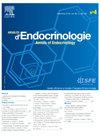Efficacy and safety of palopegteriparatide treatment in adults with hypoparathyroidism: 3-year results from the phase 3 PaTHway trial
IF 2.9
3区 医学
Q3 ENDOCRINOLOGY & METABOLISM
引用次数: 0
Abstract
Introduction
Palopegteriparatide is a prodrug of PTH(1-34), administered once daily, designed to provide active PTH within the physiological range for 24 hours/day. It is approved in the US, EU, and several other countries. This analysis evaluated the long-term efficacy and safety of palopegteriparatide in adults with chronic hypoparathyroidism through week 156 of PaTHway, a phase 3 trial with a 26-week randomized, double-blind, placebo-controlled period, followed by an open-label extension.
Results
At week 156, 89% (73/82) of participants remained in the trial; of those, 96% were independent from conventional therapy (no active vitamin D and ≤ 600 mg/day elemental calcium) and 88% had normal albumin-adjusted serum calcium (2.07–2.64 mmol/L) with a mean (SD) of (2.2 [0.2] mmol/L). Mean (SD) serum phosphate (1.1 [0.2] mmol/L) and calcium × phosphate product (2.5 [0.4] mmol2/L2) remained within normal ranges. Mean (SD) eGFR was 78.0 (14.5) mL/min/1.73 m2, reflecting a mean (SD) increase of 8.8 (11.9) mL/min/1.73 m2 from baseline (P < 0.0001); 59% and 43% of participants had an increase in eGFR of ≥ 5 mL/min/1.73 m2 and ≥ 10 mL/min/1.73 m2, respectively. Mean (SD) 24-hour urine calcium levels normalized with palopegteriparatide treatment, remaining below the upper limit of normal (≤ 250 mg/day) through week 156 (162.1 [117.8] mg/day). TEAEs were mostly grade 1 or 2, with no new safety signals identified.
Discussion
Through year 3 of the PaTHway trial, retention rate was high and palopegteriparatide demonstrated consistent longer-term safety and efficacy, which included the maintenance of serum and urine biochemistries within normal levels and sustained improvement in renal function.
palopegteriparatide治疗成人甲状旁腺功能低下的有效性和安全性:来自3期PaTHway试验的3年结果
palopegteriparatide是PTH的前药(1-34),每天给药一次,旨在提供生理范围内24小时/天的活性PTH。它已在美国、欧盟和其他几个国家获得批准。该分析通过PaTHway第156周评估palopegteriparatide治疗成人慢性甲状旁腺功能减退症的长期疗效和安全性,PaTHway是一项为期26周的随机、双盲、安慰剂对照期的3期试验,随后是开放标签延长期。结果在第156周,89%(73/82)的受试者仍留在试验中;其中96%独立于常规治疗(无活性维生素D和≤600 mg/天的单质钙),88%的白蛋白调节血清钙正常(2.97 - 2.64 mmol/L),平均(SD)为(2.2 [0.2]mmol/L)。平均(SD)血清磷酸盐(1.1 [0.2]mmol/L)和钙×磷酸产物(2.5 [0.4]mmol2/L2)保持在正常范围内。平均(SD) eGFR为78.0 (14.5)mL/min/1.73 m2,较基线平均(SD)增加8.8 (11.9)mL/min/1.73 m2 (P < 0.0001);59%和43%的受试者eGFR分别升高≥5 mL/min/1.73 m2和≥10 mL/min/1.73 m2。平均(SD) 24小时尿钙水平在palopegteriparatide治疗后恢复正常,直到第156周(162.1 [117.8]mg/天)仍低于正常上限(≤250 mg/天)。teae大多为1级或2级,没有发现新的安全信号。通过PaTHway试验的第3年,保留率很高,palopegteriparatide显示出一致的长期安全性和有效性,包括维持血清和尿液生化在正常水平和肾功能的持续改善。
本文章由计算机程序翻译,如有差异,请以英文原文为准。
求助全文
约1分钟内获得全文
求助全文
来源期刊

Annales d'endocrinologie
医学-内分泌学与代谢
CiteScore
4.40
自引率
6.50%
发文量
311
审稿时长
50 days
期刊介绍:
The Annales d''Endocrinologie, mouthpiece of the French Society of Endocrinology (SFE), publishes reviews, articles and case reports coming from clinical, therapeutic and fundamental research in endocrinology and metabolic diseases. Every year, it carries a position paper by a work-group of French-language endocrinologists, on an endocrine pathology chosen by the Society''s Scientific Committee. The journal is also the organ of the Society''s annual Congress, publishing a summary of the symposia, presentations and posters. "Les Must de l''Endocrinologie" is a special booklet brought out for the Congress, with summary articles that are always very well received. And finally, we publish the high-level instructional courses delivered during the Henri-Pierre Klotz International Endocrinology Days. The Annales is a window on the world, keeping alert clinicians up to date on what is going on in diagnosis and treatment in all the areas of our specialty.
 求助内容:
求助内容: 应助结果提醒方式:
应助结果提醒方式:


